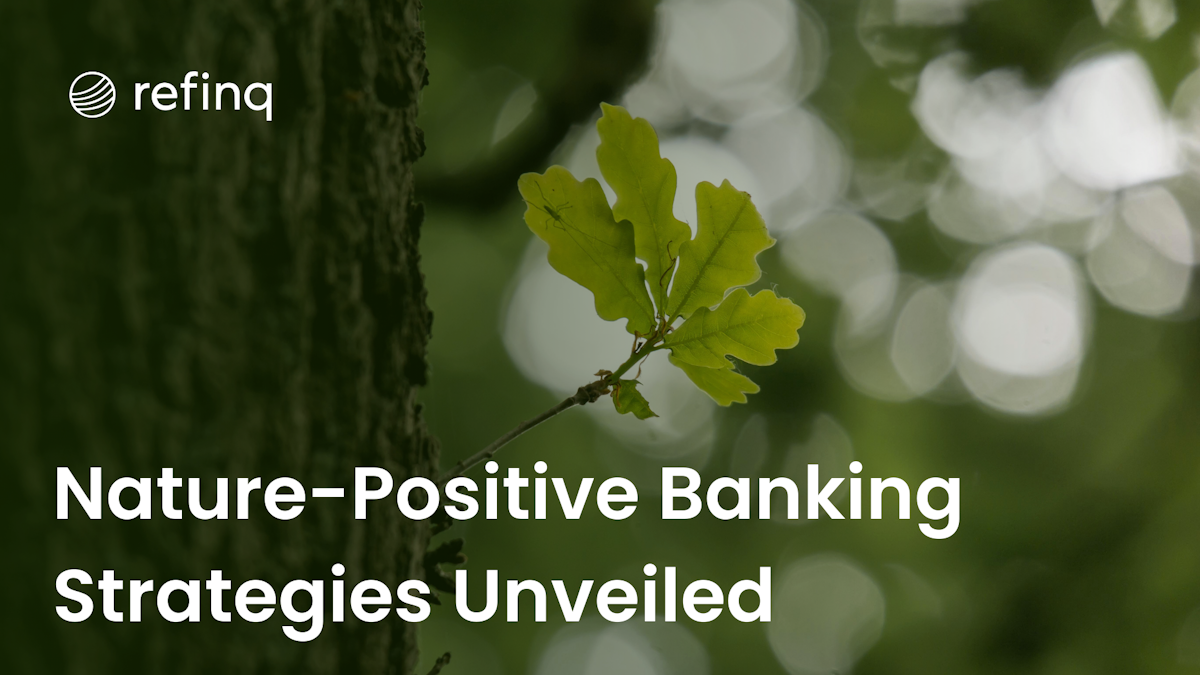Nature-Positive Strategies for Banking

Financial institutions play a pivotal role in transitioning toward a nature-positive economy. Banks are not only responsible for assessing financial risks but also for understanding their impact on biodiversity and ecosystems. Leveraging tools like Refinq allows financial institutions to make informed decisions by integrating nature-related data into their strategies.
This article explores nature-positive banking pathways, the importance of aligning financial operations with environmental sustainability, and actionable steps banks can take to contribute to biodiversity conservation. Learn more about the United Nations Environment Programme Finance Initiative’s guidelines for nature-positive finance.
Understanding Nature-Positive Banking
What Is Nature-Positive Banking?
Nature-positive banking refers to financial strategies and policies that actively contribute to the preservation and restoration of biodiversity. These approaches involve:
Investing in Nature: Allocating funds to projects that conserve or restore natural habitats.
Risk Management: Identifying and mitigating risks associated with biodiversity loss.
Sustainable Financing: Prioritizing loans and investments that support environmentally friendly practices.
Explore more about the WWF's Banking on Nature report.
Why Is Nature-Positive Banking Essential?
Financial Risks Tied to Biodiversity Loss
Biodiversity loss poses significant risks to the global economy, impacting industries dependent on natural resources. For instance:
Agriculture: Crop failures due to declining pollinator populations.
Energy: Disruptions in renewable energy projects relying on stable ecosystems.
Tourism: Loss of revenue from degraded natural attractions.
Banks can use platforms like Refinq to evaluate the environmental impact of their investments and identify risk-prone sectors.
Meeting Regulatory and Market Demands
Governments and regulatory bodies are increasingly mandating nature-related financial disclosures. Frameworks like the Taskforce on Nature-related Financial Disclosures (TNFD) guide banks in aligning their practices with global biodiversity goals.
Learn more about Deloitte's three-stage approach to implementing nature-positive strategies.
Strategies for Nature-Positive Banking
1. Incorporating Nature Metrics
Banks can adopt biodiversity and ecosystem service metrics to assess their environmental impact. Platforms like Refinq provide real-time data and forecasts to help institutions evaluate their portfolios’ nature-related risks.
Explore how Refinq enables comprehensive footprinting assessments.
2. Aligning Investments with Nature Goals
Financial institutions should prioritize investments in sectors like:
Renewable Energy: Supporting sustainable energy projects.
Eco-Tourism: Financing initiatives that promote biodiversity conservation.
Sustainable Agriculture: Funding agricultural practices that enhance soil health and biodiversity.
Learn more about nature-positive projects from the Asian Development Bank.
3. Enhancing Transparency and Reporting
Nature-positive banking requires transparency in reporting nature-related impacts. Adopting tools like Refinq ensures compliance with frameworks like CSRD and ESRS by providing audit-ready reports enriched with asset-specific data.
Find out more about banking for nature protection.
Expanding the Strategies for Nature-Positive Banking
1. How Can Banks Align Lending and Investment Practices With Nature-Positive Goals?
To align their practices, banks can:
Conduct Environmental Due Diligence: Evaluate the ecological impact of investments using platforms like Refinq.
Finance Renewable Energy: Prioritize clean energy projects that reduce dependency on fossil fuels.
Support Nature-Based Solutions: Invest in reforestation, wetland restoration, and biodiversity enhancement projects.
Discover how WWF emphasizes aligning financing practices with ecosystem health.
2. Enhancing Portfolio Management With Nature Metrics
Banks must adopt biodiversity-focused metrics to assess their environmental footprint. Using tools like Refinq, institutions can:
Measure the biodiversity impact of their portfolios.
Forecast risks under various climate scenarios.
Align with global biodiversity standards.
Explore Refinq’s portfolio impact solutions for a comprehensive approach.
The Role of Refiq in Nature-Positive Banking
Refiq offers cutting-edge tools to empower financial institutions in their journey toward nature-positive strategies. Its capabilities include:
Advanced Risk Assessments: Processing over 2.5 billion environmental data points to provide actionable insights into biodiversity risks.
Scenario Forecasting: Evaluating the long-term impact of investments under various climate scenarios.
Regulatory Compliance: Aligning operations with global standards like TNFD and CSRD.
By leveraging Refiq’s solutions, banks can prioritize sustainable investments, enhance their risk management frameworks, and contribute meaningfully to biodiversity conservation.
Conclusion
Nature-positive banking is not just a moral imperative but also an economic necessity. Financial institutions have the power to drive global biodiversity conservation by aligning their investments with nature-positive strategies. Tools like Refiq offer the technological support needed to navigate this transition, ensuring banks remain resilient while contributing to a sustainable future.
Relevant Links
A Three-Stage Approach for Banks to Implement Nature-Positive Strategies (Deloitte WSJ)
Banking Sector’s Role in Transitioning to a Nature-Positive Economy (Deloitte UK)